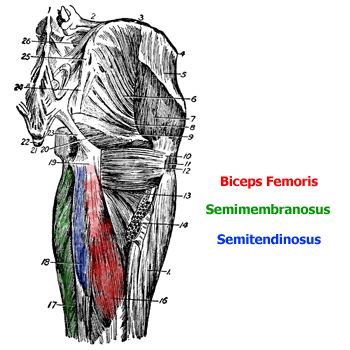The Hamstring
HAMSTRING
Here's are some interesting facts to bore the missus and mates down the pub.
Word Origin
The word hamstring originally referred to the fat and muscle at the back of the knee region. The word “string” in this case refers to the tendon. It wasn’t until the 18th century in Paris when butchers would suspend their ham (pig) by their legs in the window shops from the tendons located next to the knee and thighbone You can locate the hamstring muscles in the rear portion of the thigh. The “ham” portion of the word refers to the pig that butchers would hang in their shop window, as pigs are often referred to as ham. Butchers would frequently hang these hams by a “string” threaded through the pig’s leg, and so the area the pig was hung by was referred to as the “hamstring.”
The Hamstrings are actually comprised of three separate muscles:the Biceps Femoris, Semitendinosus and Semimembranosus.The hamstring is the back of your thigh, or the muscles that make up the area. It extends from the hip to the knee.
The semitendinosus, semimembranosous and biceps femoris muscles are commonly known as the hamstrings and these together with the gluteus maximus muscle are used together in running (Barry Butler) jumping skipping and hopping and in your case walking at a pace.
Strains & Injuries
Strained hamstring or more commonly called pulled hamstring is the excessive stretch or tear of the muscles fibres and tissues. This sort of injury is common among individuals who engage in strenuous sports that use the lower extremities. However, it can happen to anyone. Nowadays, rigidity of hamstring is common. This describes the principle of detraining, or in layman’s terms “use it or lose it.” Actions like sitting for prolonged periods of time can result in the loss of hamstring muscle growth and may cause hamstring rigidity.
The hamstring is essentially a fast-twitch muscle, reacting to low reps and powerful movements. In motion, knee bending is not the “main” role of the hamstring. As in walking or running, the hamstrings key function is to control the movement of the leg.
What does a hamstring strain feel like?
Mild hamstring strains may not hurt too much. But severe ones can be agonizing, making it impossible to walk or even stand.
Other possible symptoms of a hamstring strain are:
Sudden and severe pain during exercise, along with a snapping or popping feeling
Pain in the back of the thigh and lower buttock when walking, straightening the leg, or bending over Tenderness
Bruising
What’s the treatment for a hamstring strain?
Luckily, minor to moderate hamstring strains usually heal on their own. You just need to give them some time. To speed the healing, you can:
Rest the leg. Avoid putting weight on the leg as best you can. If the pain is severe, you may need crutches until it goes away. Ask your doctor or physical therapist if they’re needed.
Ice your leg to reduce pain and swelling. Do it for 20-30 minutes every three to four hours for two to three days, or until the pain is gone.
Compress your leg. Use an elastic bandage around the leg to keep down swelling.
Elevate your leg on a pillow when you’re sitting or lying down.
Take anti-inflammatory painkillers. Non-steroidal anti-inflammatory drugs (NSAIDs), like ibuprofen (Advil, Motrin) or
n aproxen (Aleve, Naprosyn) will help with pain and swelling. However, these drugs may have side effects, such as an increased risk of bleeding and ulcers. They should be used only short term, unless your doctor specifically says otherwise.









